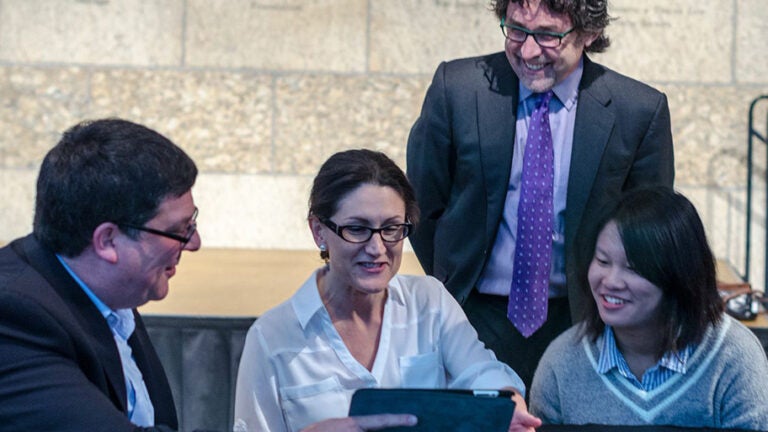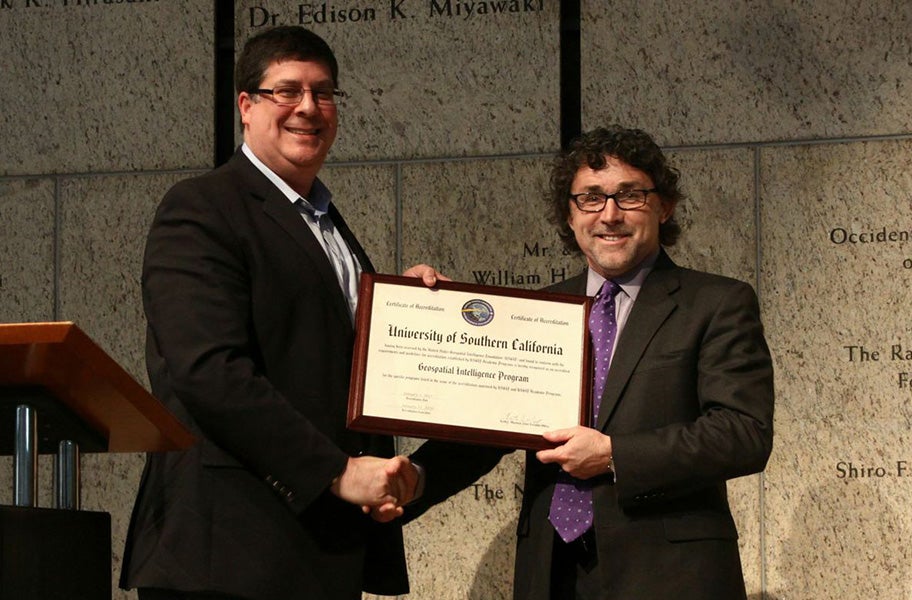
Spatial Connections
In 1854, British physician John Snow drew a map of London, tracing a severe outbreak of cholera back to the city’s Broad Street water pump. The link led to Snow’s breakthrough discovery that cholera is spread by contaminated water.
This early intersection between geographic information science (GIS) and epidemiology was cited at the fifth annual Los Angeles Geospatial Summit as leaders in public health discussed how the capacities of today’s GIS technology have accelerated innovations in disease prevention and the promotion of community health.
Featuring many innovators in the world of geographic information science and technology (GIST), the event, hosted by USC Dornsife’s Spatial Sciences Institute (SSI), was held on Feb. 27 at the Japanese American National Museum in downtown Los Angeles and drew more than 150 professionals, students, faculty and alumni.
Among them were location-based software developers, sensor system developers and developers of the technology behind the processing and dissemination of collected information from unmanned aerial systems (UAS), or drones, who shared insights into how the data is used in commercial and government applications.
One of the highlights of the summit was the announcement by Keith Masback, CEO of the United States Geospatial Intelligence Foundation (USGIF), that SSI’s Graduate Certificate in Geospatial Intelligence (GEOINT) Program had received accreditation from his organization.
John Wilson, director of SSI, said the institute was honored by the USGIF accreditation.
“With this accreditation, students who graduate with our GEOINT certificate will also receive the USGIF Geospatial Intelligence Certificate as further evidence of their career readiness to work in areas such as disaster management, human security and international relief applications,” said Wilson, professor of sociology, civil and environmental engineering, computer science and architecture.
Wilson noted that SSI collaborates with an array of researchers, businesses, nonprofits, NGOs and other entities from a wide range of disciplines and industries to analyze, model and visualize location-based data.
“Although there are many geospatial conferences across the country and around the world, our summit has the distinctive mission to connect current leaders in the spatial sciences with students from numerous different academic institutions who will be, and sometimes already are, the next generation of innovators,” he said.

John Wilson (right) receives a certificate of accreditation for USC Dornsife’s Spatial Sciences Institute Graduate Certificate in Geospatial Intelligence Program from the U.S. Geospatial Intelligence Foundation’s Keith Masback. (Photo: Anne Marie Maltes.)
The annual summit provides students with the opportunity to learn more about emerging trends in geospatial science, technology and applications; to present papers and posters about their own research; to network with industry professionals; and to introduce themselves to geospatial company representatives at the closing Industry and Job Fair.
These industry professionals also benefit from the chance to create greater awareness for their companies by sharing materials at the fair, to meet other geospatial professionals and to provide insights on how academic programs can best prepare the next generation of GIS professionals.
Presentations from eight students representing six different academic institutions throughout Southern California were also featured while 13 presented posters. From SSI’s GIST program, USC students Ana Stoudt, Michael Quant and Sarah Gehring presented papers, and Carlos Martinez, Rachel Rodriquez and Andrew Thomason presented posters.
“The high quality of the student paper and poster presentations is such that professionals attending the summit are learning as much from students as they are from the excellent keynote and industry panel speakers,” Wilson said.
“Summit attendees had a rare opportunity to hear from and talk with industry leaders such as Gil Elbaz, CEO of Factual, and representatives of companies such as The Aerospace Corporation, BAE Systems, PIXIA and PricewaterhouseCoopers, all of which are utilizing geospatial sciences and technologies in leveraging location-based data into applications from agriculture to healthcare delivery,” said Susan Kamei, associate director of SSI.
A number of SSI’s online M.S. in GIST students, who are located throughout the country, traveled to L.A. to attend the event. “It’s a great opportunity for them to be with our faculty, meet fellow students and GIST Graduate Program alumni, and to visit the campus,” Kamei said.
Among the SSI alumni who attended the summit was Emily Frazier who earned her M.S. in GIST from USC Dornsife in 2014. Frazier was offered a job with Nokia’s HERE Maps in Los Angeles a month before completing her thesis for the USC GIST Program.
“I literally defended my thesis at the end of August and began my new job as a Geographic Analyst the first week in September 2014,” she said.
As a geographic analyst for Nokia’s HERE Maps, Frazier assists in finding sources for new and updated map content, ensuring accurate representation of real-world conditions, as well as collecting field data for Southern California and Hawaii.
“My team and I drive to different locations with a multi-camera, GPS-receiving vehicle to take video of new roads and areas in need of updates. We do this to not only update our system, but to enhance the connected car driving experience for our customers,” Frazier said. “This is the most exciting part of my job since I get to travel frequently and don’t have to be stuck in an office in front of a computer all day. It’s like a mini road trip every week.”
“With her newly found job and career path, Emily is just one example of how SSI creates wonderful career opportunities for our GIST graduates,” Wilson said.